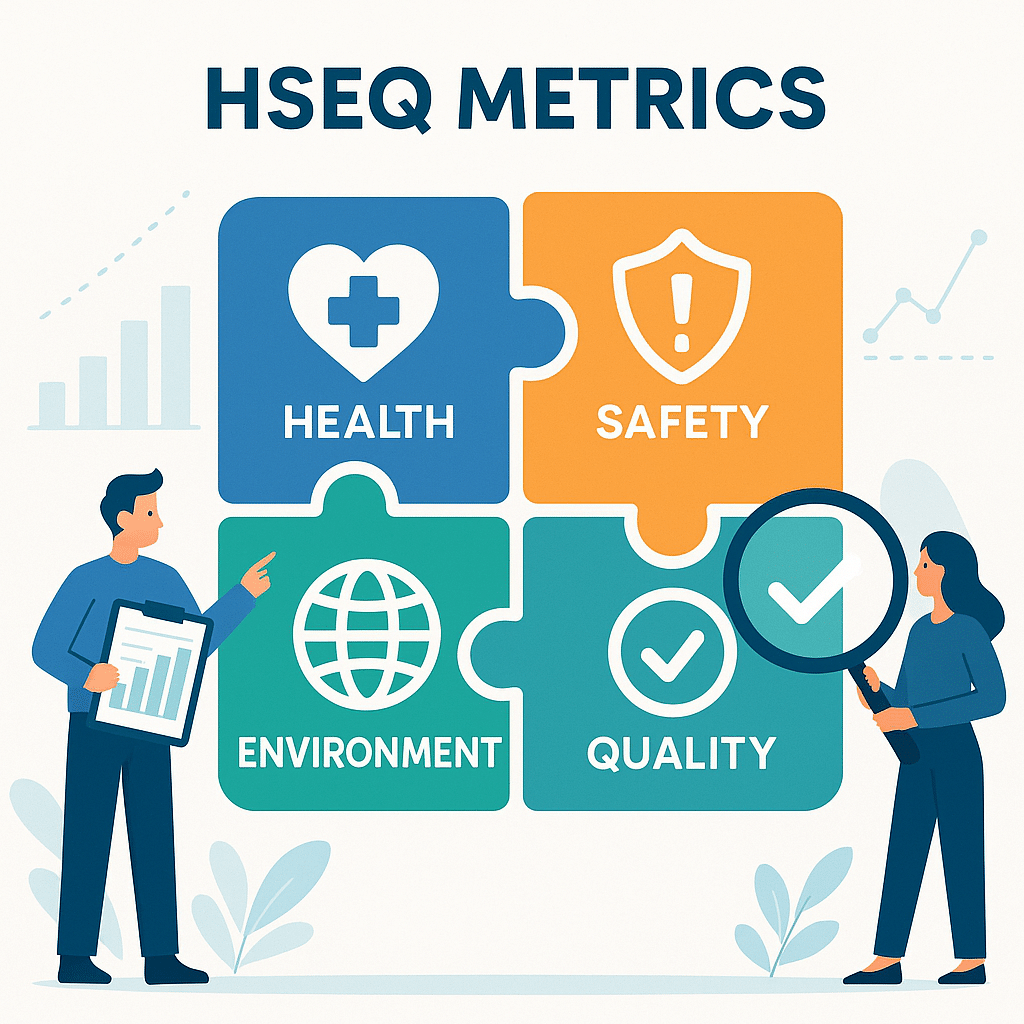HSEQ Metrics are essential tools that organizations use to measure performance, identify areas for improvement, and support strategic decision-making across Health, Safety, Environment, and Quality domains.
Whether you’re in construction, healthcare, manufacturing, or maritime operations, choosing the right metrics is the difference between reactive compliance and proactive excellence.

This article explores the most impactful HSEQ metrics, how they contribute to safety and quality performance, and why they are essential for businesses striving toward operational efficiency and regulatory compliance.
What Are HSEQ Metrics?
HSEQ Metrics are quantifiable indicators used to track and assess an organization’s performance in four key areas:
- Health: Measures that monitor occupational health status and absenteeism.
- Safety: Statistics tracking incident rates, near misses, and unsafe behaviors.
- Environment: Indicators showing impact on natural resources, emissions, and waste.
- Quality: Metrics evaluating process consistency, product defects, and customer satisfaction.
An effective HSEQ program uses leading (proactive) and lagging (reactive) indicators to get a full picture of system performance and risks.
Why Are HSEQ Metrics Important?
Without data, safety, environmental, and quality management becomes guesswork. With the right HSEQ metrics in place, organizations can:
- Identify risk trends before incidents occur
- Support compliance with ISO standards and legal requirements
- Make informed decisions on training, processes, and investments
- Showcase performance to stakeholders and clients
- Build a culture of continuous improvement
Metrics turn abstract values like “safe” or “sustainable” into measurable goals.
Top HSEQ Metrics for Driving Safety and Quality
1. Lost Time Injury Frequency Rate (LTIFR)
Definition: Number of lost time injuries per million hours worked.
This is a core lagging indicator for workplace safety. A high LTIFR signals safety system failures. It’s critical in industries like construction and oil & gas.
Formula:
(Lost Time Injuries ÷ Total Hours Worked) x 1,000,000
2. Total Recordable Injury Frequency Rate (TRIFR)
Definition: Includes all OSHA-reportable incidents: lost time, medical treatment, and restricted work.
TRIFR provides a more comprehensive view than LTIFR and helps organizations identify repeat injury causes.
3. Near Miss Reporting Rate
Definition: Number of reported near misses per worker or per hour.
Leading indicator: A rising rate of near miss reporting can indicate improved hazard awareness and employee engagement.
Encouraging near miss reporting prevents actual incidents and improves safety culture.
4. Occupational Illness Rate
Definition: Frequency of work-related health conditions reported.
Used in health-sensitive industries (e.g., mining, healthcare), this metric monitors the long-term effectiveness of exposure controls.
5. Corrective Action Closure Rate
Definition: Percentage of corrective actions closed within the target timeframe.
This metric demonstrates how responsive your HSEQ system is in resolving non-conformities or hazards identified during audits, inspections, or incidents.
6. Environmental Incident Rate
Definition: Number of reportable environmental events per period.
It includes:
- Spills
- Emissions above limits
- Waste mismanagement
Goal: Minimize harm and maintain compliance with environmental laws like ISO 14001 and local regulations.
7. Waste Recycling Ratio
Definition: Percentage of waste materials recycled versus total waste generated.
This metric supports sustainability goals and ESG reporting. Higher recycling rates typically reflect improved resource efficiency.
8. Customer Complaint Rate
Definition: Number of quality complaints per 100 or 1,000 units delivered.
This is a quality metric that impacts brand trust and regulatory standing (especially in pharma, food, and manufacturing). A declining trend signals system maturity.
9. First Pass Yield (FPY)
Definition: Percentage of products manufactured correctly the first time without rework.
A key metric in lean and Six Sigma operations. High FPY = low defect rate = higher efficiency and quality.
10. Audit Compliance Score
Definition: Percentage of audit items that pass without major findings.
Can apply to internal, external, or third-party HSEQ audits. This is a balanced indicator of process discipline, document control, and field compliance.
BONUS: HSEQ Training Completion Rate
Definition: The percentage of required HSEQ training courses completed by staff within a period.
A simple but powerful leading indicator. Low training completion rates often precede spikes in incidents.
How to Use HSEQ Metrics Effectively
- Select Relevant KPIs: Align them with organizational goals and legal obligations.
- Combine Leading & Lagging Metrics: Don’t rely only on incident data—track proactive efforts.
- Visualize Data: Use dashboards and heatmaps to identify trends quickly.
- Act on Insights: Metrics are only valuable when they drive decisions and improvements.
- Benchmark: Compare against industry peers or internal performance targets.
Tools to Track HSEQ Metrics
- SafetyCulture iAuditor – for audits and inspections
- EcoOnline – for environmental compliance and incident logging
- ETQ Reliance – for quality and HSEQ integration
- Microsoft Power BI / Tableau – for custom dashboards
- OHSE.ca Templates – free downloadable HSEQ KPI spreadsheets
Internal & External Resources
- See our article on Integrated HSEQ Management Systems – OHSE.ca
- Read about PDCA Cycle for Continuous Improvement – American Society for Quality (DoFollow)
- ISO Management Standards – ISO.org (DoFollow)
- OHSE Toolbox Talks Collection – OHSE.ca
- Leading vs Lagging Indicators – OSHA (DoFollow)
Final Thoughts on HSEQ Metrics
Choosing and tracking the right HSEQ metrics can transform your workplace from reactive to proactive, and from compliant to excellent.
These metrics offer insights into what’s working, what’s not, and where to focus improvement efforts. Whether you’re trying to reduce incidents, meet ISO standards, or improve customer trust, metrics are your roadmap.

A data-driven HSEQ system isn’t just about compliance — it’s about creating a smarter, safer, and more successful organization.
Leave a Reply